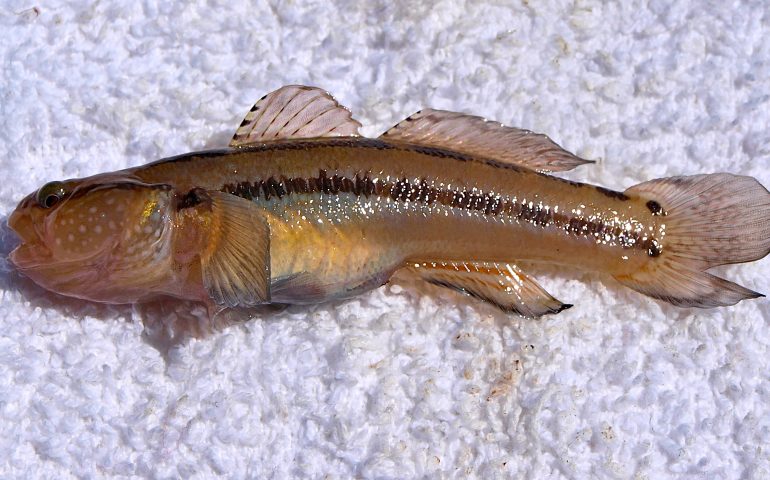Gobies: Family Gobiidae
Species: Tridentiger trigonocephalus (Gill, 1859).
Alternate Names: Striped goby, trident goby and specklefaced goby, Japanese goby, striped tripletooth goby (Russian Federation), polosatyi trekhzubyi bychok (Russian Federation), shimahaze (Japan).
Identification: Fat with a wide, flat head; typical goby shape. The coloring is generally brownish-gray with dark mottling and spots but its name comes from its ability to rapidly switch (in seconds) between a light and dark form. When in the light form, it bears two horizontal stripes that run the length of the body, one towards the top and one along the middle of the body. The dark form exhibits vertical bars that give the fish a mottled appearance. In this form, the horizontal stripes are only faintly visible, outlined by a thin row of yellow scales. Dark bars, which are visible in both forms, are located at the base of the pectoral fin and on the area just before the tail. A yellow area, which is very conspicuous when the fish is in the dark form, follows the bar at the pectoral fin. Chameleons usually have usually small light spots on side of head and a small black spot at the upper base of the caudal fin. Having said all that, sometimes they are black overall.
Size: Up to 4.4 inches.
Range: An alien species from Asia (China, Korea, Siberia and Japan) that is considered an “aquatic invader.” Three isolated populations in California—San Diego Bay, Los Angeles Harbor and San Francisco Bay. In San Francisco Bay they are common along the San Francisco waterfront (especially the Hunter’s Point area), the south Bay (especially San Mateo and the Dumbarton Bridge area), and all along the Oakland waterfront (including Lake Merritt), and Berkeley’s Aquatic Park.
Habitat: Shallow-water mudflat areas in bays and lagoons; found in crevices of barnacles and other fouling organisms; would feel at home in an aquatic bar since they like to hang out in beer cans and broken bottles.
Piers: Occasionally caught from piers and the best bets would seem to be along the Oakland waterfront. I’ve only taken them from three piers—the San Antonio Pier, the Union Point Pier (Wave Oculus Pier), and the now closed Franklin D. Roosevelt Pier—all located in Oakland.
Shoreline: An infrequent catch by shore anglers in San Francisco Bay.
Boats: An inshore species rarely take from boats.
Bait and Tackle: Caught incidentally while fishing on the bottom for other species. Since they are small, most are taken by anglers using small hooks when fishing for perch or other species.
Food Value: Too small to eat but may be used as a live bait.
Comments: These babies apparently began to traverse the Pacific highway to California by the late 1950s. They were first collected in American waters on June 1, 1960 by J. Wright of Marineland of the Pacific at Fish Harbor in Los Angeles Harbor. They were first noted in (south) San Francisco Bay in 1962. How did they get here? No one is sure. Hubbs and Prescott (1965), suggested that chameleons might have reached San Francisco Bay in egg stages on the giant Pacific or Japanese oyster (Crassostrea gigas), and Los Angeles Harbor among fouling organisms on a ship. Haaker (1979), speculated it may have involved the transport of eggs laid on fouling organisms of ship hulls, or from the contents of aquariums dumped from ships. Matern and Fleming (1995), were of the opinion that it was through ships’ ballast water. Does it matter? Not anymore as regards this species since it is now well established. It is important as regards the future introduction or prevention of additional exotic species.
Apparently these Lilliputians like to use old oyster or clam shells as their nesting sites (in Japan they spawn in Oyster beds). Eggs are deposited on the inner surface of the shell in a single layer by one or more female fish. The male guards the nest, and eggs hatch in 8-1/2 days. In the absence of shells they’ll use cans and bottles as spawning substrates; in the absence of shells, cans or bottles, they’ll use crevices in jetties or rocks. Chameleons (some) reach the ripe old age of three years. According to Elkhorn Slough Research “chameleon gobies are aggressive and voracious predators of crustaceans, polychaetes, gastropods and fish eggs. Capable of feeding in total darkness and tolerant of wide ranges of salinity, temperature, and pollution, they may be able to outcompete native predators, including other gobies.”
